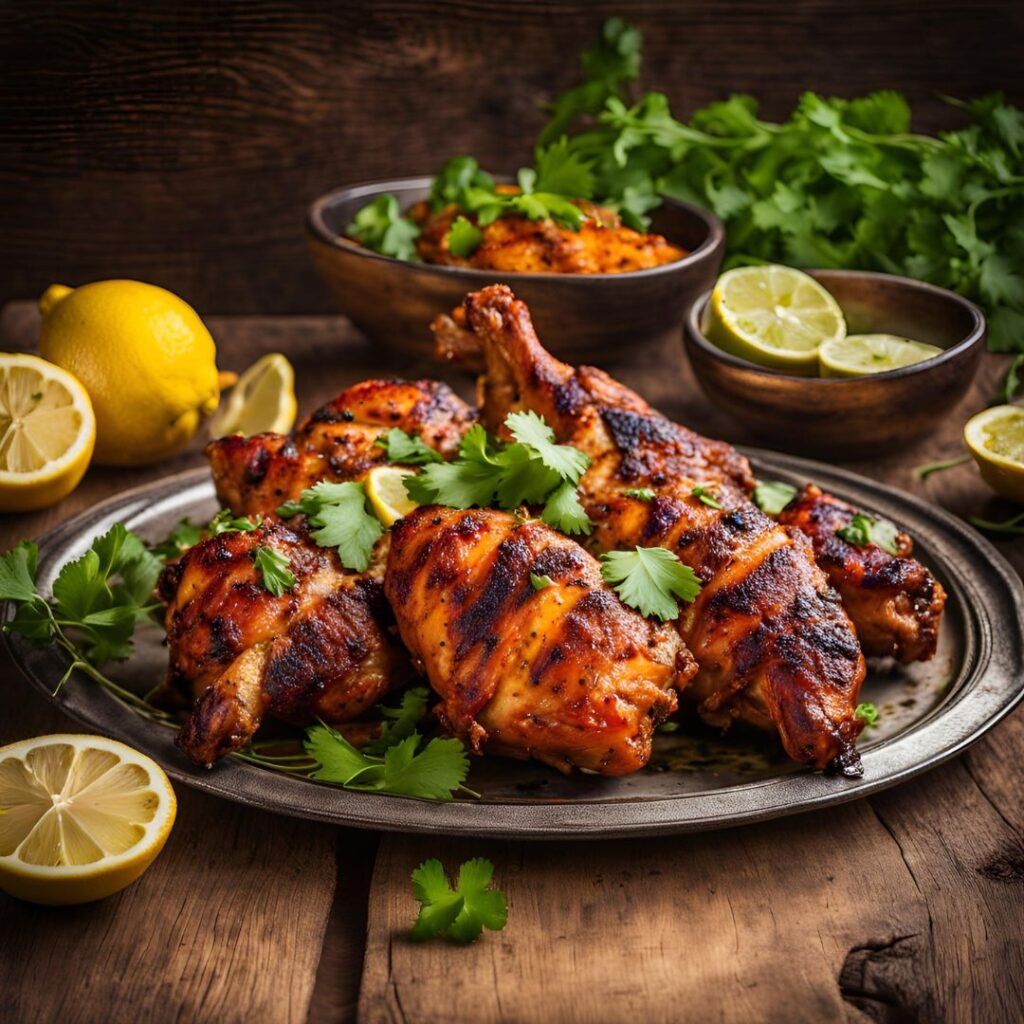

Tandoori Chicken Recipe : A Flavorful Journey Through India’s Culinary Tradition. Tandoori chicken, a dish synonymous with the rich and vibrant culinary heritage of India, has captured the hearts and palates of food lovers across the world. This beloved recipe is more than just a meal; it is a celebration of flavors, history, and culture, steeped in centuries of tradition. Its unique smoky aroma, rich color, and blend of spices make it a standout dish in Indian cuisine, and its popularity has spread far beyond the subcontinent.
In this article, we’ll explore the origins of tandoori chicken, its cultural significance, the distinct flavors and ingredients that define it, and the cooking methods that have elevated it to global fame. Whether you’re an experienced cook or a newcomer to the world of Indian cuisine, understanding the story behind tandoori chicken will deepen your appreciation for this iconic dish.
The word “tandoori” refers to a traditional clay oven, known as a tandoor, which has been used for cooking in South Asia for thousands of years. This cooking technique was originally brought to India by Persian invaders, who used the tandoor for baking bread and roasting meats. Over time, the tandoor became an essential part of Indian cooking, particularly in the northern regions like Punjab, where the cuisine is heavily influenced by Persian and Central Asian flavors.
Tandoori cooking involves high heat, with food placed inside the oven to cook using direct flames or hot coals. The heat and cooking method impart a distinct smoky flavor that is integral to tandoori dishes. While the tandoor was historically used to prepare a variety of foods—bread, lamb, and vegetables—it was the tandoori chicken that truly captured the world’s attention.
The modern tandoori chicken as we know it today, however, traces its origins to the 1940s. According to popular lore, the dish was invented by Kundan Lal Gujral, a chef and restaurateur from Delhi, who is said to have first made tandoori chicken in his restaurant, Moti Mahal, around 1947. The chef’s innovative approach to marinating chicken in a mix of yogurt and spices before cooking it in the tandoor gave birth to a dish that would go on to become an international sensation.
While Moti Mahal is often credited with popularizing tandoori chicken in India and beyond, it’s essential to understand that the dish’s roots are deeply embedded in the regional cooking practices of India, with many variations of tandoori-style dishes existing long before it became widely known.
Tandoori chicken is not merely a meal; it is an expression of India’s rich cultural tapestry. Food, in Indian tradition, is deeply intertwined with community, celebration, and family. Whether served at a wedding feast, a festive occasion, or a simple family dinner, tandoori chicken is often seen as a dish for special occasions. Its preparation is considered a craft in many Indian households and restaurants, where the art of marination and cooking is passed down through generations.
The cooking method itself—using a tandoor—has become a symbol of authentic Indian cuisine, and in many ways, the tandoor is regarded as an icon of India’s culinary prowess. Even though modern kitchens may use ovens or grills to replicate the cooking process, the tandoor remains a symbol of tradition and an essential tool for creating the deep, smoky flavors that tandoori chicken is known for.
In India, tandoori chicken is often served with a variety of accompaniments, such as naan (Indian flatbread), raita (a yogurt-based side dish), and aromatic rice dishes like biryani. This combination makes for a well-rounded meal that is both flavorful and satisfying. Tandoori chicken is also enjoyed at roadside stalls, upscale restaurants, and at home, making it a truly versatile dish that brings people together across different social and economic backgrounds.
Beyond India, tandoori chicken has gained popularity worldwide, particularly in countries like the United Kingdom, the United States, Canada, and Australia. In the West, it has become a fixture on Indian restaurant menus and has even inspired fusion dishes. Its accessibility and the bold, inviting flavors have made it a favorite among those unfamiliar with Indian cuisine.
What sets tandoori chicken apart from other grilled or roasted chicken dishes is the careful balance of spices, the marinade, and the high-heat cooking technique. At its core, tandoori chicken is about layering flavors. The marinade, typically made with yogurt and a mix of spices, is the key to the dish’s signature taste and texture. The acidity of the yogurt tenderizes the chicken, while the spices infuse it with a depth of flavor.
Common spices used in tandoori chicken include turmeric, which imparts a beautiful golden hue and earthy flavor; red chili powder, which provides both heat and vibrant color; cumin and coriander, which add aromatic warmth; and garam masala, a spice blend that imparts richness and complexity. Other ingredients such as ginger-garlic paste, lemon juice, and kasuri methi (dried fenugreek leaves) are often added to enhance the depth of flavor.
The addition of food coloring, particularly red, is another hallmark of tandoori chicken, giving the dish its signature fiery appearance. While this is purely cosmetic and optional, it has become a standard feature in many restaurant versions, helping to make tandoori chicken even more visually appealing.
The smoky flavor is another key characteristic of tandoori chicken. When cooked in a traditional tandoor, the high heat and the smoky environment impart a unique aroma to the chicken, which is difficult to replicate in modern ovens. However, grilling or broiling the chicken can still deliver a smoky result, especially if done over charcoal or wood.
The end result is a chicken that is tender on the inside, slightly crispy on the outside, and bursting with flavors. Each bite is a harmonious blend of spices, tang, and smokiness, making it a truly unforgettable experience for the senses.
In recent decades, Indian cuisine has gained immense popularity around the world, and tandoori chicken has become one of its most recognizable dishes. Indian restaurants, particularly in Western countries, have helped spread the love for this vibrant dish, often serving it as part of a larger array of curries, breads, and side dishes.
The advent of food culture through social media, food blogs, and culinary television shows has further contributed to the widespread recognition of tandoori chicken. People from all walks of life, regardless of their background, are now drawn to the bold flavors and diverse textures that tandoori chicken offers. Whether prepared at home or enjoyed at a restaurant, it remains a symbol of India’s rich culinary diversity and its ability to adapt and thrive on the global stage.
Tandoori chicken is much more than just a dish; it is a testament to the ingenuity and cultural depth of Indian cuisine. Rooted in ancient cooking traditions and perfected over generations, tandoori chicken has evolved into a beloved dish enjoyed by people around the world. From its smoky aroma to its vibrant colors and bold flavors, it captures the essence of what makes Indian food so special: a beautiful balance of spice, technique, and tradition. Whether you're making it for a special occasion or enjoying it with friends and family, tandoori chicken remains a dish that brings people together, transcending borders and cultures, one delicious bite at a time.
You can either cook the tandoori chicken in an oven or on a grill. Here’s how to do both:
Option 1: Oven Cooking
Option 2: Grill Cooking
Yes, you can use boneless chicken for tandoori, but traditionally, bone-in chicken (like drumsticks or thighs) is preferred. The bone helps retain moisture during cooking and contributes to a juicier result. Boneless chicken will cook faster but may lack the same depth of flavor and tenderness. If using boneless chicken, marinate for the same amount of time and reduce the cooking time slightly to avoid overcooking.
For the best flavor and tenderness, you should marinate the chicken for at least 2-3 hours. However, for deeper flavor and juicier results, marinating the chicken for 12-24 hours in the refrigerator is ideal. If you're short on time, even 30 minutes to 1 hour of marination will still impart great flavor.
Yes, you can skip the food coloring. The red food coloring is commonly used to give tandoori chicken its signature vibrant appearance, but it’s purely cosmetic. The color doesn’t affect the taste. If you prefer a more natural approach, the chicken will still taste delicious without it. If you want the chicken to have a rich color, you can use a pinch of paprika or kashmiri red chili powder, which adds both color and a mild, smoky flavor.
Yes, you can definitely make tandoori chicken without a traditional tandoor. In fact, most people make it using an oven or grill. The key to success is to cook the chicken at high heat to achieve the signature smoky flavor and charred exterior. If using an oven, use the broiler function to get that charred finish. If grilling, cook the chicken over direct heat on a preheated grill.
The smoky flavor comes from the high-heat environment of the tandoor. If you’re cooking tandoori chicken in an oven or on a grill, you can still replicate the smoky effect using the “dhungar” method.
To do this, heat a piece of charcoal until it’s red hot, place it in a small bowl, and pour a little ghee or oil over it. Cover the chicken with a lid and let it sit for about 10-15 minutes to infuse the smoke.
The key to juicy tandoori chicken is in the marination. The yogurt in the marinade acts as a tenderizer, and letting the chicken marinate for a longer time allows the spices and yogurt to break down the muscle fibers, keeping the meat soft and moist. Make sure the chicken is well-coated in the marinade, including inside any cuts or slashes you make in the chicken. Also, avoid overcooking, as this can dry the meat out.
Tandoori chicken gets its distinctive flavor from a blend of spices. Some key ingredients include:
While these are the classic spices, you can adjust the amounts to suit your flavor preferences. For a milder version, reduce the amount of red chili powder.
No, you should not cover the chicken while cooking. The high heat helps develop the smoky flavor and crispy exterior that tandoori chicken is known for. Covering the chicken can trap moisture and prevent the skin from getting crispy. If baking in the oven, place the chicken on a wire rack over a baking sheet to allow air circulation, helping to achieve an even, crispy exterior.
Tandoori chicken is done when the internal temperature of the meat reaches 165°F (74°C). You can use a meat thermometer to check for doneness. The chicken should also have a golden-brown, slightly charred exterior, and the juices should run clear when pierced with a fork. If grilling, check by cutting into the thickest part of the chicken. The meat should no longer be pink, and the juices should be clear.
Yes, tandoori chicken can be made in advance. You can marinate the chicken ahead of time (up to 24 hours) and then cook it on the day you plan to serve it. Leftover cooked tandoori chicken can also be stored in the refrigerator for 2-3 days and reheated, though it’s best when freshly cooked. If you plan to reheat leftovers, gently warm the chicken in the oven at a low temperature (about 300°F/150°C) to avoid drying it out.
Enjoy the yum :)